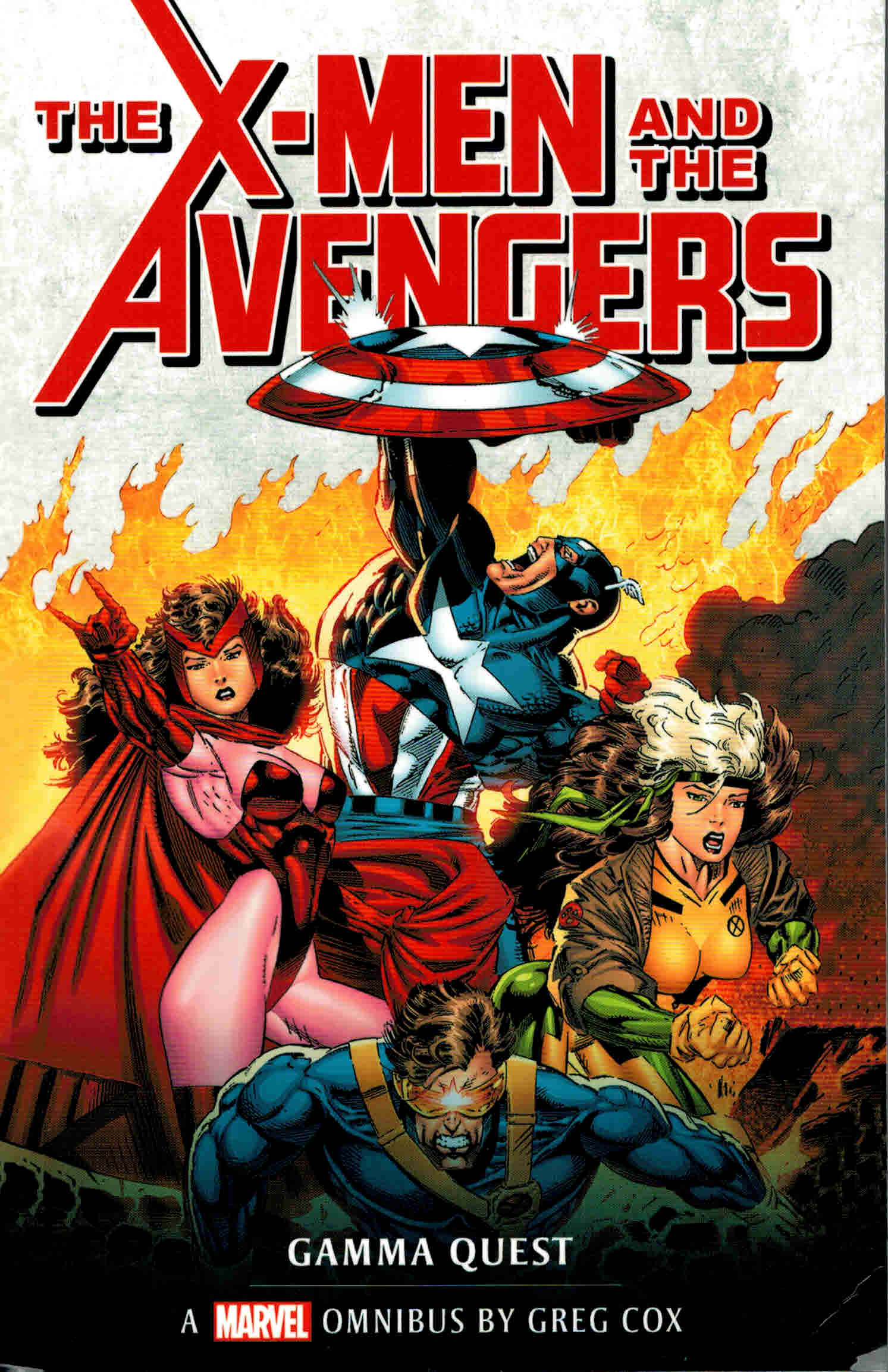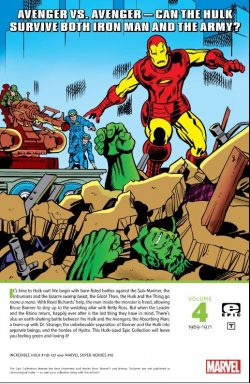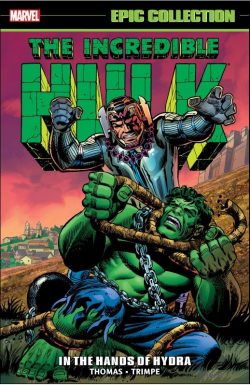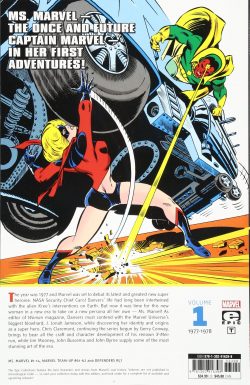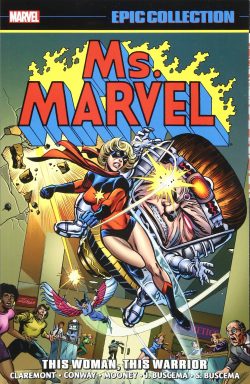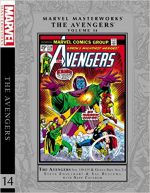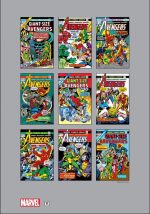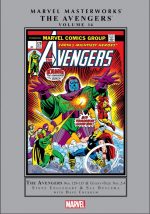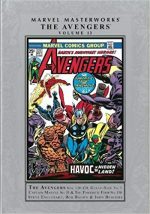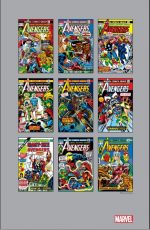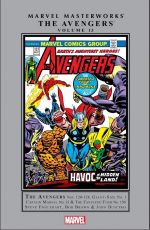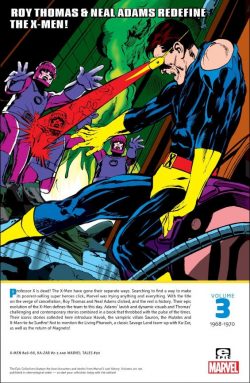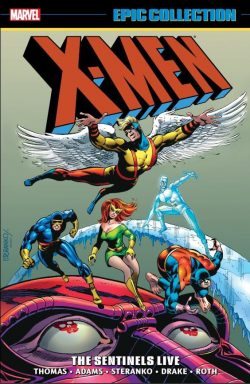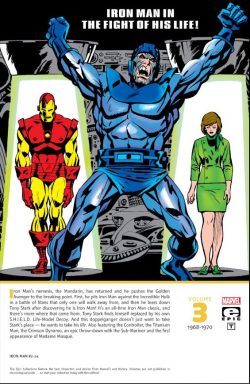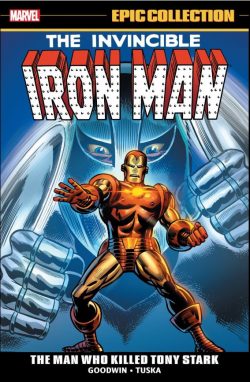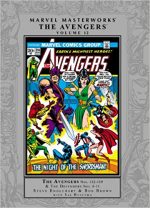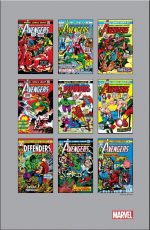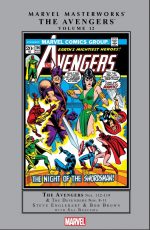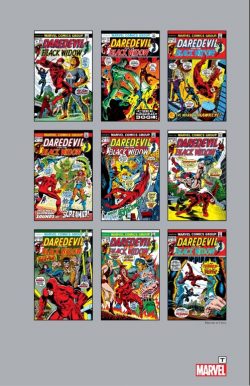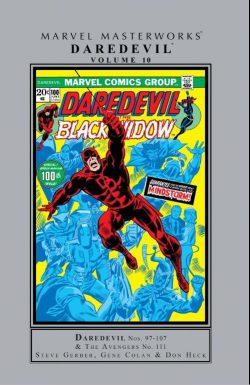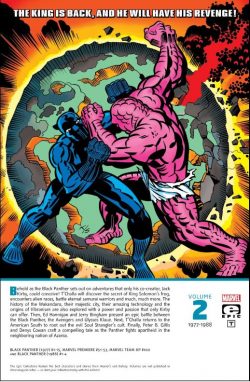
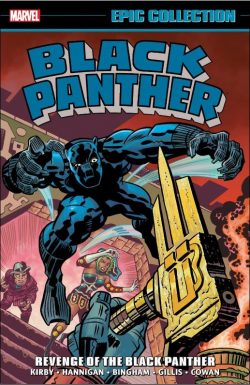
By Jack Kirby, Ed Hannigan, Peter B. Gillis, Jim Shooter, Chris Claremont, John Byrne, Jerry Bingham, Denys Cowan & various (Marvel)
ISBN: 978-1-3029-1542-1 (TPB)
Acclaimed as the first black superhero in American comics and one of the first to carry his own series, the Black Panther‘s popularity and fortunes have waxed and waned since he first appeared in Fantastic Four. In fact, back then the cat king actually attacked Marvel’s First Family as part of an extended plan to gain vengeance on the murderer of his father. He was also the first black superhero in American comics, debuting in summer 1966.
As created and realised by Jack Kirby & Stan Lee, T’Challa, son of T’Chaka, is an African monarch whose secretive kingdom is the only source of vibration-absorbing wonder mineral Vibranium. The miraculous alien metal – derived from a fallen meteor which struck the continent in lost antiquity – is the basis of the country’s immense wealth, enabling Wakanda to become one of the wealthiest and most secretive nations on Earth. These riches allowed the young king to radically remake his country, creating a technological wonderland even after he left Africa to fight as one of America’s mighty Avengers.
For much of its history Wakanda has been an isolated, utopian technological wonderland with the tribal resources and people safeguarded and ruled since time immemorial by a human warrior-king deriving cat-like physical advantages from secret ceremonies and a mysterious heart-shaped herb. This has ensured the generational dominance of the nation’s Panther Cult and Royal Family.
Wakanda has never been conquered by outsiders. The primary reason is an unbroken line of divinely-sponsored warrior kings who safeguard the united, unified tribes. Another is that miraculous super-mineral found nowhere else on Earth. The top-secret “Vibranium mound†had guaranteed the country’s status as a clandestine superpower for centuries but in modern times has increasingly made Wakanda a target for subversion, incursion and even invasion as the world grew ever smaller…
In contemporary times the chieftain is T’Challa: an unbeatable, super-smart, feline-empowered strategic genius who divides his time between ruling at home and serving abroad in superhero teams such as The Avengers, Fantastic Force, The Illuminati and The Ultimates, beside the world’s mightiest costumed champions.
This trusty trade paperback (and eBook) gathers the entire blockbusting, mind-bending reinvention by Jack Kirby and others from Black Panther volume 1 # 1-15 (January 1977-May 1979), the continuation in Marvel Premiere #51-53 (cover-dated December 1979 to April 1980), material from Marvel Team-up #100 (December 1980) and a groundbreaking, 4-issue miniseries spanning July to October 1988.
Jack Kirby’s return to Marvel in the mid 1970’s was much hyped at the time but swiftly proved to be controversial. His new creations (2001, The Eternals, Devil Dinosaur, Machine Man) found friends rapidly, but his tenure on established earlier creations Captain America and Black Panther divided the fan base.
Kirby was never slavishly wedded to tight continuity and preferred, in many ways, to treat his stints on titles as a “Day Oneâ€. His commitment was to wholesome, eye-popping adventure, breakneck action and breathless, mind-boggling wonderment. Combined with his absolute mastery of the comic page and unceasing quest for the Next Big Thrill, it all makes for a captivating read, but will never satisfy those readers fully committed to the minutiae of the Marvel Universe.
Beginning here with Black Panther #1, what they got was a rollercoaster ride of classic Kirby concept-overload as the Hereditary King of a miraculous Lost Kingdom gallantly pursues fabulous time machines, fights future men and secret samurai clans, thwarts the plots of super-rich artefact stealers and foils schemes to nuke his hidden homeland, usurp his rule and even consume his faithful subjects…
This feline funfest is about frantic action and begins at full pelt with a re-introductory romp spotlighting diminutive treasure hunter Abner Little. This devious gentleman entices T’Challa into a search for ‘King Solomon’s Frog!’ after introducing himself as a friend and colleague of the Panther’s grandfather Azzari the Wise…
Soon, the mismatched pair are in hot pursuit of a historical wonder machine that sows death and destruction in its wake. The ancient brass amphibian has the ability to open time-portals, bringing lethal threats from other eras, but its real capacity for catastrophe comes from Little’s rival Collectors, who bring astounding ordnance and unsurpassed riches into play in their own efforts to possess the mystic time-machine.
Most ruthless and relentless is Queen Zanda of Narobia, who expertly ambushes the questers with a highly-skilled mercenary taskforce before accidentally triggering the frog into shanghaiing a hyper-evolved walking WMD from his own far-flung future era. She also assures T’Challa’s continued assistance by targeting Wakanda with atomic missiles…
Reluctantly uniting to sedate ‘The Six-Million Year Man’, T’Challa, Little and Zanda then race to uncover King Solomon’s tomb where a twin of the Brass Frog rests. This particular item possesses the most welcome function of returning objects and creatures to their point of origin…
Their ‘Race Against Time’ is exacerbated when the groggy tomorrow-man revives just as the searchers locate the tomb. He angrily unleashes psionic hell and awakens King Solomon’s formidable funereal guardian Ogar. Thankfully, reluctant teamwork saves them and the newly-found second frog restores order, if not sanity…
Tragically for the tomb-raiders, the time to determine if they are ‘Friends or Foes’ swiftly passes, since the calamitous clashes have destabilised the long-lost treasury trove. With mighty explosions wracking the site, it is all T’Challa can do to drag his artefact-lusting companions to safety before Armageddon occurs…
Unfortunately for the Panther, he has proved his worth and – with Wakanda still a nuclear target – ultimate ineffectuality. When the assembled Collectors – Zanda, Count Zorba, Colonel Pigman and withered coffin-dodger Silas Mourner – see the warrior king in battle, they determine he must win for them the ultimate prize…
The ‘Quest for the Sacred Water-Skin!!’ begins as T’Challa and equally reluctant Abner Little set off to find a fabled hidden land where a sect of Samurai warriors have dwelt for centuries; sustained by honour, their martial arts and a literal fountain of youth.
Overcoming monsters and warriors, T’Challa establishes a bond of honour with the last proponents of Bushido, but sadly his venal companion upsets the applecart by secretly stealing ‘A Cup of Youth’…
Meanwhile in Wakanda, internal trouble flares when the Panther’s half-brother General Jakarra makes a power-grab, bolstered by a sacrilegious utilisation of unrefined vibranium…
Black Panther #7 sees the hero and his scurrilous sidekick escape the Samurai city even as ‘Drums!’ sound across Wakanda and the incredible secret origin of Panther Cult and Vibranium Mound are simultaneously revealed.
When the awesome sky metal first crashed to Earth in primordial times, it transformed many men into monsters. Thankfully mighty chief Bashenga – taking the black cat as his totem – created a force to destroy the creatures and police the metal: preventing alien infection from spreading and forever after shielding his people through a line of dedicated defenders.
As his latest successor heads for a final confrontation with the Collectors, King T’Challa has no way of knowing his devoted regent N’Gassi has been captured or that Jakarra has gained deadly power through exposure to the gene-warping force of raw Vibranium…
Having battled his way free, T’Challa heads for home. His people, however, are already suffering the increasingly crazed depredations of a Jakarra no longer even remotely human.
Further delayed by a mercy mission – plucking dying men from the sea – the king bemoans his absence whilst half a world away, N’Gassi takes a desperate gamble and “requests†that the sedentary royal cousins – Ishanta, Joshua Itobo, Khanata and Zuni – step up to lead the fight against Jakarra. But are they ‘Panthers or Pussycats?’…
Surprising everybody with a show of solidarity and unconventional tactics, the ‘Black Musketeers’ manage to contain the monstrous usurper until T’Challa returns, but his arrival coincides with the loss of Jakarra’s last vestige of humanity. Now a shambling beast resolvs that ‘This World Shall Die!’ in an Earth-shattering detonation. The horrific abomination is barely defeated inside the Mound by a true Black Panther who does not escape the mineral’s mutagenic properties…
Issue #11 finds T’Challa recovering from his struggle against Jakarra and plagued by eerie recurring dreams of future battles. As citizens begin vanishing all over Wakanda – including Prince Khanata – the medical team reaches the conclusion that the king has developed some form of Extra-Sensory Perception.
This new gift – or perhaps curse? – promptly leads the Panther to the abductors’ HQ where phantasmal madman ‘Kiber the Cruel’ is converting abducted humans to energy and consuming them…
Following ‘The Kiber Clue’, T’Challa strives mightily to save his kinsman and subjects, but arrives too late for anything but vengeance…
As Jim Shooter, Ed Hannigan, Jerry Bingham & Gene Day take over from the abruptly departed Kirby, the saga swiftly wraps up with the true nature of Kiber grotesquely exposed and the Panther’s judgement delivered in #13’s ‘What is… and What Should Never Be’…
With Hannigan scripting, the Black Panther rapidly re-entered the mainstream Marvel universe in ‘The Beasts in the Jungle!’ (#14 March 1979): opening Wakanda’s first Embassy in New York City, applying to the United Nations and rejoining his former allies in the Avengers.
All too soon smothered in red tape and diplomatic hurdles, T’Challa welcomes working with his superhero guests but is quickly embroiled in a deadly scheme by old enemy Klaw, the Master of Sound, and blithely unaware that other relationships are about to be renewed…
After the resurgent villain battles the World’s Mightiest Heroes to a standstill, T’Challa manages to inflict the ‘Revenge of The Black Panther!’ in the final issue (May 1979), yet leaves everything on a cliffhanging note as former lover and consort Monica Lynne breaks into the Wakandan Embassy…
When Kirby took over the character, Black Panther had just ended a highly-acclaimed run in Jungle Action. Following the epic ‘Panther’s Rage’ saga, scripter Don McGregor began an even more groundbreaking saga in ‘The Panther Versus the Klan’.
That convoluted yarn had been abruptly cancelled before conclusion the previous year, but the contents of Marvel Premiere#51-53 provided an ending to the Klan clash as well as an acceptable in-universe explanation as to why wise and noble T’Challa abruptly dropped his hunt for answers and abandoned his adored beloved Monica…
Opening minutes after Black Panther #15 finished, ‘The Killing of Windeagle!’ sees T’Challa arriving back at his new American Embassy, only to be attacked by an unknown flying warrior who claims to be an old foe.
After subduing the assailant, the King experiences even more turmoil as Lynne and Georgia journalist Kevin Trublood accost him. Although his staff all seem familiar with the woman, T’Challa has no memory of either of them…
Granting an audience with the couple, the Panther hears how Monica’s sister Angela was murdered, and how the death seemed to involve both the Ku Klux Klan and rival offshoot the Dragon’s Circle. As he listens, T’Challa hears that for a time he was the prime investigator of the murder, but his mind is clouded and he recalls none of it. Suddenly Windeagle attacks again, but as the Panther fights back his opponent is assassinated by a sniper…
Working with the police, T’Challa uncovers the sordid history of a petty gangster who somehow became a flying fury and establishes links to yet another organisation: The Spiritual Light Society. At every turn, events seem to be pushing him towards one inescapable conclusion: Monica’s ridiculous, unbelievable story is true and someone has tampered with his mind and memory…
When they are ambushed again by armed thugs – later identified as Klansmen – their spirited resistance is supplemented by more sniper fire and the Panther’s ‘Journey Through the Past!’ impels him to invade a Klan gathering. This conclave is subsequently violently disrupted by a costumed maniac called Soul Strangler…
Despite not remembering, the Panther believes he’s deduced the nature of the contemporary civil war between KKK and Dragon’s circle, and more importantly, who killed Angela. With resignation and trepidation, T’Challa, Kevin and Monica head for a showdown in the Deep South…
Inked by Alan Gordon, Marvel Premiere #53 delivered ‘The Ending, In Anger!’ as T’Challa visits Monica’s family home and the dam in his memory finally shatters. Acting with clarity at last, the Black Panther tracks down the villains who captured and brainwashed him during his previous visit, exposes a tawdry truth behind all the death and intimidation and brings a kind of closure to all the innocents touched by the tragedy…
With the major story-arcs at last concluded it was back to relative obscurity and bit-parts for the Panther, with the exception of a short tale that would have huge repercussions on the hero’s life in the future.
‘Cry… Vengeance!’, by Chris Claremont, John Byrne & Bob McLeod, first appeared in Marvel Team-Up #100 and saw African X-Man Storm targeted by assassins. Easily defeating her attackers, she learns they were hired by Boer hardman Andreas de Ruyter…
This sends her mind winging back to her childhood journey across Africa as teenager: an arduous trek made easier after she linked up with a young boy on his own rite of passage ritual. His name was T’Challa and she learned that he was a prince only after South African mercenaries led by de Ruyter tried to kidnap the boy for political advantage.
After driving the thugs off, the youngsters spent a brief but idyllic time together before their paths diverged and duty pulled them apart.
Decades later, the villain is back and seeking vengeance, so Ororo reunites with the boy the world now calls Black Panther to end the maniac’s threat forever…
As the 1980s closed, the Panther made a dynamic comeback in 1988, courtesy of writer Peter B. Gillis and illustrators Denys Cowan & Sam DeLarosa…
The Black Panthers rule over a fantastic African paradise which isolated itself from the rest of the world millennia ago. Blessed with unimaginable resources – both natural and not so much – the nation of Wakanda developed uninterrupted into the most technologically advanced human nation on Earth, utterly unmolested by rapacious European imperialism. That did not mean that geographical neighbours were allies, however…
In ‘Cry, the Accursed Country!’ technologically-advanced white nationalist country Azania has subjugated and tormented its own black majority population for centuries whilst plotting the downfall of Wakanda. As global condemnation of the apartheid regime mounts, T’Challa learns that the Panther God has withdrawn his blessing and instead consecrated and empowered an imprisoned priest in Azania as a new Black Panther. When this savage avatar begins inflicting bloody retribution on the ruling class, the Azanians blame Wakanda…
Deprived of his feline gifts and herding war-hungry dissidents in his own nation, T’Challa faces a crisis of confidence – and faith – in ‘For Duty, For Honor, For Country!’ which is no help when Azania targets Wakanda with its own team of super-agents: The Supremacists…
Soon T’Challa’s people face international condemnation and nuclear Armageddon after ‘The Moorbecx Communique!’ adds layers of espionage to the escalating crisis, compelling the outcast king to risk his principles and challenge his god to regain his birthright in ‘A Cat Can Look at a King…’
Most tragically, the Panther must defeat his dark mirror image and knows that win or lose, nothing will ever be the same again…
This collection is also augmented by Kirby-era Editorial pages, house ads, a potted history of the Black Panther from #14, the Rich Buckler & McLeod cover to the never-released BP #16 and unused Bingham pencil pages. Also on show, are info pages and maps of Wakanda from The Official Handbook of the Marvel Universe, featuring T’Challa, Klaw, Klaw’s Blaster, Vibranium, and Kiber the Cruel.
There are also text features from Marvel Age #20 and #63; covering the much-delayed Gillis/Cowan revival, plus a pinup by Bill Reinhold, and Kirby/Ernie Chan and Al Milgrom/Klaus Janson original art pages as well as unused Bingham pencils to feast your eyes upon…
An explosive rocket ride of thrills, spills, chills and too-long delayed gratification, these long-lost classics confirm the Black Panther as one of the most complex and versatile characters in comics and simply scream “Read me! Read me!†So you should and you must…
© 1977, 1978, 1979, 1980, 1988, 2019 Marvel. All rights reserved.
